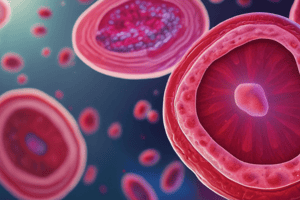Podcast
Questions and Answers
What is the likely cause of incompatible results with post-transfusion samples but compatible with pre-transfusion samples?
What is the likely cause of incompatible results with post-transfusion samples but compatible with pre-transfusion samples?
- Presence of antibodies in the recipient's blood
- Intrinsic red cell defect
- Bacterial contamination of the donor unit
- Anamnestic antibody response (correct)
What is the next step in investigation if both crossmatches are compatible but there is strong clinical evidence of acute immune hemolytic reaction?
What is the next step in investigation if both crossmatches are compatible but there is strong clinical evidence of acute immune hemolytic reaction?
- Stop the transfusion immediately
- Perform antibody detection tests using more sensitive techniques (correct)
- Administer steroids to the patient
- Repeat the crossmatch
What is the purpose of examining post-transfusion urine for the presence of free hemoglobin or hemosiderin?
What is the purpose of examining post-transfusion urine for the presence of free hemoglobin or hemosiderin?
- To diagnose acute kidney injury
- To detect hemolysis (correct)
- To assess blood transfusion reaction
- To monitor kidney function
Why is it important to measure serum haptoglobin in both pre and post transfusion samples?
Why is it important to measure serum haptoglobin in both pre and post transfusion samples?
What is the purpose of testing the donor unit for the corresponding antigen?
What is the purpose of testing the donor unit for the corresponding antigen?
What is indicated by a negative hemolysis test and a negative DAT?
What is indicated by a negative hemolysis test and a negative DAT?
What is the next step in investigation if there is a discrepancy in patient/donor identification?
What is the next step in investigation if there is a discrepancy in patient/donor identification?
What is the interpretation of a positive hemolysis test and/or a positive DAT?
What is the interpretation of a positive hemolysis test and/or a positive DAT?
What is the purpose of repeating ABO/RH typing and antibody screening in further investigation?
What is the purpose of repeating ABO/RH typing and antibody screening in further investigation?
What is the result of incompatible crossmatch with both pre and post transfusion samples against the sample of the donor?
What is the result of incompatible crossmatch with both pre and post transfusion samples against the sample of the donor?
What is the significance of antibody complement-coated cells being rapidly destroyed?
What is the significance of antibody complement-coated cells being rapidly destroyed?
What is the primary purpose of the autocontrol test in an investigation of incompatible crossmatch?
What is the primary purpose of the autocontrol test in an investigation of incompatible crossmatch?
What is the potential cause of a positive reaction in the saline at 37°C stage of investigation?
What is the potential cause of a positive reaction in the saline at 37°C stage of investigation?
What is the importance of grading donor reactions in the investigation of suspected hemolytic transfusion reaction?
What is the importance of grading donor reactions in the investigation of suspected hemolytic transfusion reaction?
What is the purpose of rechecking the Rh type in the investigation of incompatible crossmatch?
What is the purpose of rechecking the Rh type in the investigation of incompatible crossmatch?
What is the significance of a positive DAT result in the investigation of suspected hemolytic transfusion reaction?
What is the significance of a positive DAT result in the investigation of suspected hemolytic transfusion reaction?
What is the primary step in the investigation of incompatible crossmatch?
What is the primary step in the investigation of incompatible crossmatch?
Flashcards are hidden until you start studying




